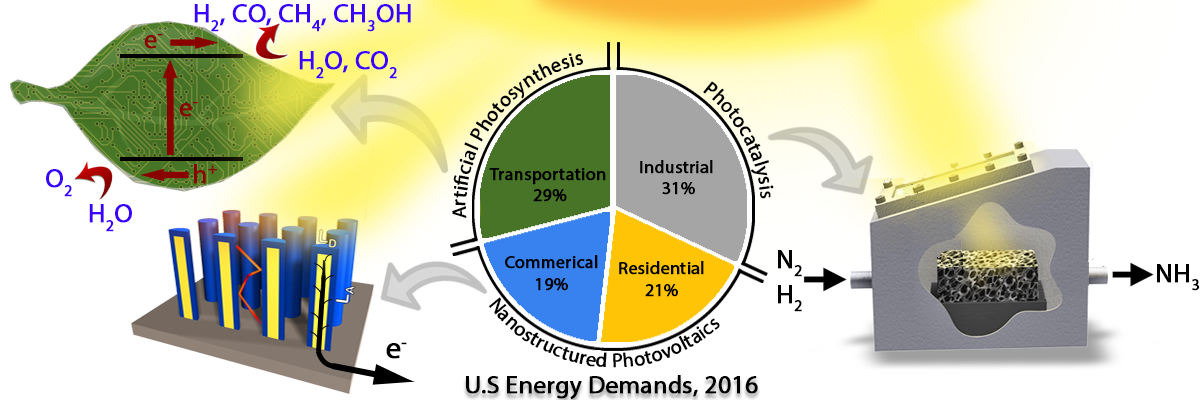The sun fuels our planet in many ways, providing thermal, electrical, and chemical potential energy. Our lab develops materials and strategies for three approaches for harnessing solar energy: 1) photovoltaics, 2) solar-to-fuel conversion, and 3) solar photocatalytic chemical transformations. Each approach is described briefly below:
1) Si photovoltaic (PV) cells are the most well-known form of modern solar energy conversion. However, while the price of Si PV cells has dropped dramatically in the past decade, we are starting to face fundamental limitations to decreasing the cost of Si PVs further. To achieve the U.S Department of Energy’s SunShot 2030 goals will require new approaches to decrease the $/Watt of cells, which can be achieved by either reduced materials/processing costs, or increased efficiency. To reduce manufacturing costs, our group explores nanostructured architectures consisting of earth-abundant materials that avoid the need for high temperature processing. To extend efficiency limits beyond single-junction Si, tandem solar cells are the natural technological evolution to improve efficient utilization of incident sunlight. Given the high performance perovskite-based solar cells, perovskite/Si tandem solar cells represent a potential low-cost pathway to boosting Si efficiency. Our research in this area is aimed at mass-producing high efficiency and low cost tandem solar cells, by to finely tuning material properties at interfaces with high throughput nanomanufacturing processes.
2) Owing to the intermittent nature of solar energy, finding new ways to store it for subsequent human use is a critical energy challenge, to provide fuels for the transportation sector, enable grid-scale load leveling, and drive industrially relevant chemistry. The process of solar-to-fuel conversion using semiconductor photoelectrochemistry is termed “artificial photosynthesis”, and mimics natural photosynthesis to store solar energy in the form of useful fuels such as hydrogen or hydrocarbons. Solar driven fuel production, using CO2 and H2O as inputs, provides a path for closed-loop, carbon-neutral, and sustainable fuel sources. Our group studies nanostructured semiconductors for enhanced light absorption and charge transfer, as well as atomically precise surface and interfacial modifications, to manufacture efficient, scalable, and sustainable direct solar-to-fuel systems.
3) While photovoltaics are effective for generating electricity, they do not currently have a strong impact on the industrial and transportation sectors. We are exploring radical new approaches to photocatalysis in order to boost the kinetics of reactions such as Haber-Bosch ammonia synthesis. Sunlight-assisted ammonia synthesis offers the unique possibility of influencing the energy-intensive and heavily-polluting industrial fertilizer production, which accounts for 1-2% of global energy use alone. This approach could be further applied in the future to reduce fossil-fuel heat inputs to industrial processing, which represents approximately 30% of U.S. Energy Use .
Selected Publications:
(8) Z. J. Berquist, A. J. Gayle, N. P. Dasgupta, A. Lenert “Transparent Refractory Aerogels for Efficient Spectral Control in High-Temperature Solar Power Generation” Adv. Funct. Mater. 32, 2108774 (2022) [link]
(7) A. R. Bielinski, A. J. Gayle, S. Lee, N. P. Dasgupta “Geometric Optimization of Bismuth Vanadate Core-Shell Nanowire Photoanodes using Atomic Layer Deposition” ACS Appl. Mater. Interfaces. 13, 52063 (2021) [link]
(6) A. R. Bielinski, S. Lee, J. J. Brancho, S. L. Esarey, A. J. Gayle, E. Kazyak, K. Sun, B. M Bartlett, N. P. Dasgupta, “Atomic Layer Deposition of Bismuth Vanadate Core-Shell Photoanodes” Chem. Mater. 31, 3221 (2019). [link]
(5) R. E. Rodríguez, S. P. Agarwal, S. An, E. Kazyak, D. Das, W. Shang, R. Skye, T. Deng, and N. P. Dasgupta, “Biotemplated Morpho Butterfly Wings for Tunable Structurally Colored Photocatalysts”, ACS Appl. Mater. Interfaces 10, 4614 (2018). [link]
(4) S. Lee, A. R. Bielinski, E. Fahrenkrug, N. P. Dasgupta, and S. Maldonado, “Macroporous p-GaP Photocathodes Prepared by Anodic Etching and Atomic Layer Deposition Doping”, ACS Appl. Mater. Interfaces 16178 (2016). [link]
(3) A. B. Wong, S. Brittman, Y. Yu, N. P. Dasgupta and P. Yang, “Core–Shell CdS–Cu2S Nanorod Array Solar Cells”, Nano Lett. 15, 4096 (2015). [link]
(2) N. P. Dasgupta and P. Yang “Semiconductor Nanowires for Solar Photovoltaic and Photoelectrochemical Energy Conversion”, Front. Phys. 9(3), 289 (2014). [link]
(1) C. Liu, N. P. Dasgupta and P. Yang, “Semiconductor Nanowires for Artificial Photosynthesis”, Chem. Mater. 26, 415 (2014). [link]

